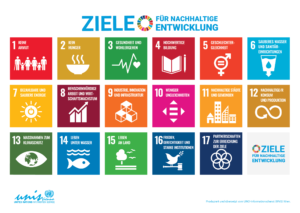Promoting Sustainable Development Goals
“Everyone, including the philanthropic community, has a huge role to play and can do more to make a larger impact. […] Unless the level of ambition and collaboration increases, there’s no way we’ll meet the targets.”
Kathy Calvin, former President of the UN Foundation
The Sustainable Development Goals (SDGs) are global goals for sustainable development by 2030, which were adopted by the United Nations and therefore apply to all countries. Poverty, hunger, climate change and conflicts are to be reduced or, ideally, ended. The SDGs serve as a framework for the communication, measurability and implementation of sustainability goals at the international level.
The SDGs are not only aimed at states, international organisations and companies. Private organisations such as foundations can make decisive contributions to their achievement – with financial resources, but above all as venture capitalists and innovators. According to estimates, foundations worldwide spent USD 40 billion annually between 2016 and 2019 on global initiatives dedicated to the SDGs. The SDG Philanthropy Platform estimates that philanthropic organisations will provide over USD 650 billion by 2030.
Excursus: The emergence of the SDGs
Never before in human history has the impact of people on the world we live in been so great. Man-made climate change is offset by incredible advances in medicine and technology. Conflicts are being started and ended, massive capital flows are leading to changes in economic conditions in many countries. While poverty and hunger are declining in some regions, crises are breaking out again in others, destroying progress.
Against this backdrop, the United Nations adopted eight Millennium Development Goals (MDGs) in 2000. By 2015, poverty and hunger were to be reduced, diseases combated and environmental destruction ended in developing countries. In some areas, astonishing progress was made that was not previously thought possible, particularly in the fight against poverty.
After numerous international consultations and negotiations, new goals were adopted in 2015 for the period up to 2030, the SDGs. Unlike the MDGs, these did not primarily place the onus on developing countries, but on all states. A total of 169 sub-goals were defined for the 17 goals, which have shaped the international agenda ever since.
Details on the individual goals can be found on the website of the Regional Information Centre of the United Nations.

What characterises the SDGs?
The SDGs were developed to protect nature and create a fairer world. This requires all social actors, such as business, science and civil society, to make a contribution. In order to implement the SDGs in developing countries, international systems such as the financial system, the global market, knowledge and technology must be made accessible to all countries.
Where do we stand with the implementation?
An important part of the 2030 Agenda is to regularly monitor the implementation of the SDGs. To this end, indicators have been defined on which all countries report regularly. These indicators can be found in a United Nations database. The British NPO Global Change Data Lab has developed the SDG tracker to visualise the status quo of each country in terms of achieving the SDGs. Progress towards achieving the SDGs and their sub-goals can be visualised interactively for each region of the world on various world maps.
Exacerbated by the coronavirus pandemic, it does not currently look as though all SDGs will be achieved by 2030. Firstly, there is a need for political action in many areas. Secondly, it is estimated that additional investments totalling CHF 2 to 4 trillion per year would be required to achieve the goals.
What contribution can philanthropy and foundations make?
Foundations and philanthropists are important players on the road to a sustainable and just world (see also the talk “Committed to sustainability”). With its financial resources, philanthropy plays a strategic role in achieving the SDGs. In addition, philanthropic organisations can contribute to the scaling of solutions for the SDGs with their expertise and networks.
Other qualities complement this approach, such as the courage to think big in the form of big bets, the ability to innovate, a willingness to take risks and a willingness to cooperate.
Where can I find more information?
For philanthropists and foundations who want to get involved in the SDGs, the internet offers numerous opportunities for cooperation and support:
Country reports
Countries have defined indicators for the achievement of the SDGs and their sub-targets. In Germany, Destatis has published an overview of the various goals and the current status, while the UK publishes an annual report . Similar reports can be found in Liechtenstein, in the form of the government report on the implementation of the 2030 Agenda. They provide inspiration as to where there is an acute need for action and where philanthropic organisations can become even more active.
SDG Action App
The SDG Action App provides a simple overview of the SDGs and allows you to find out more about relevant projects on specific SDGs, set up your own projects and find out about events.
World Economic Forum (WEF) Transformation Map
The Transformation Map of the WEF offers an interactive way to understand topics of international relevance in their interdependence. More than 250 strategic topics, such as climate change and artificial intelligence, have been presented.
Active Philanthropy, Foundation Guide
For foundations, we recommend Active Philanthropy’s Climate guide, which shows how foundations can make a contribution to combating climate change through their donation portfolios and strategies.
Foundation 20
The foundation platform Foundation 20 is a global association of 60 foundations that are committed to the SDGs and combating the climate crisis by building bridges between government agencies, business and society.
PhilanthropyForClimate
More than 600 foundations have joined the global PhilanthropyForClimate initiative and have committed to taking action against climate change.
SDGFunders
SDGFunders emerged from the SDG Philanthropy Platform and collect data on the contribution of foundations to the SDGs and their graphic impact, whereby foundations from the USA are currently primarily represented. Nevertheless, it is possible to recognise which SDGs have received less investment to date and in which regions fewer foundations are active.
Catalyst 2030
Catalyst 2030 is a global network of more than 3,700 people and over 2,400 organisations who want to work together to ensure that the SDGs are actually achieved by 2030.
The SDGs – an opportunity for foundations and philanthropists
The SDGs provide guidance on global priorities on the path to a sustainable and just world. Aligning your own activities with the SDGs makes it easier to find like-minded people, launch joint projects or forge alliances. The SDGs therefore play an important role as a beacon, and not just for globally active organisations.

